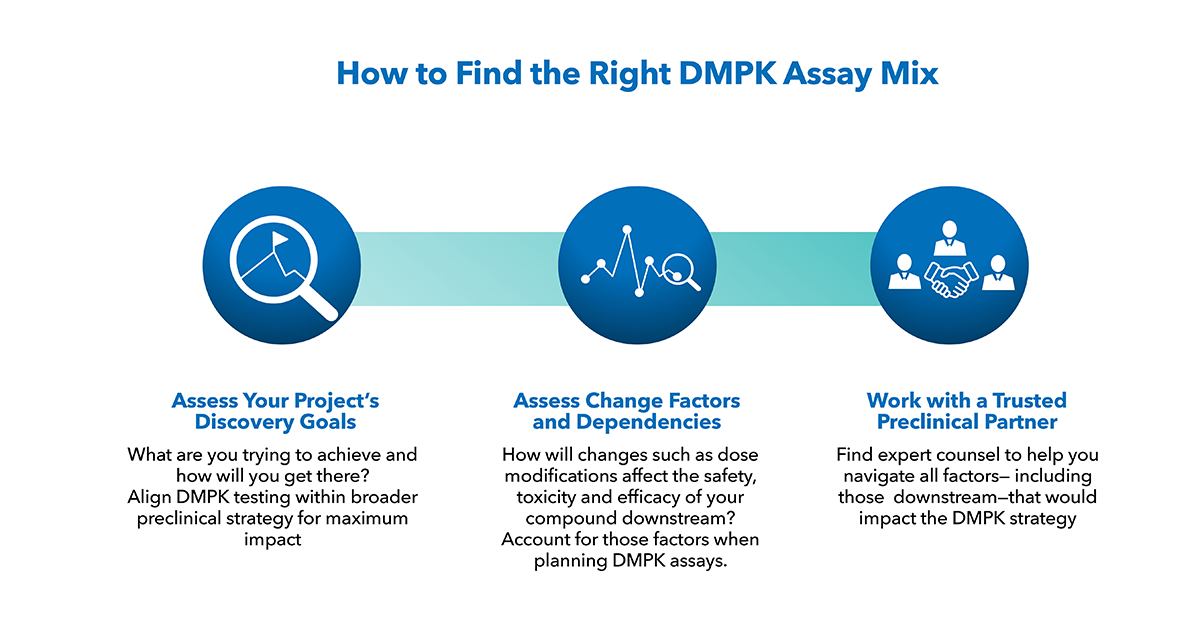You might know you need to conduct drug metabolism and pharmacokinetic (DMPK) analysis, but which tests are right for your project? And are you doing them at the right time? When building your preclinical strategy, these questions matter—and that’s true now more than ever, as new drug classes and targets emerge.
After all, earlier and more complete DMPK analysis leads to reduced attrition during drug development, which can help to quickly and efficiently spot metabolic or pharmacokinetic liabilities that could limit future development. But how do you know which assays to run? Refer to this alphabetical guide to learn about common DMPK assays, from what they do to when and why you might need them.
The Dictionary of DMPK Assays
Bioanalytical Method Development and Validation: Important analytical method to quantify analyte or compound(s) of interest during DMPK screening.
Blood-to-Plasma Ratio: Compounds can remain in the plasma compartment, but they can also be sequestered by red blood cells—which makes plasma concentrations misleading. This assay identifies a drug’s distribution between the two.
CYP High-Throughput Screening: Microplate-based assays with fluorometric detection to screen for compound inhibition during early discovery.
CYP/UGT Reaction Phenotyping: Uses individually expressed enzymes to: 1) Identify specific routes of metabolism, and 2) Determine drug-drug interactions.
Dose Confirmation Analysis of Formulation Samples (LC-MS/MS or UV-VIS): Analysis of dosing solutions to verify concentrations in formulations.
Dried Blood Spot (DBS): Enables multiple sampling with limited blood draws.
ELISA for Antibody PK: Immunoassays that determine concentrations of an analyte of interest.
Hepatocytes Stability: Enables full metabolic testing within the liver to 1) Identify a drug’s stability, and 2) Calculate a test compound’s intrinsic clearance.
LC-MS/MS (Liquid Chromatography and Mass Spectrometry): The analytical technique of choice at different stages during drug discovery up to late development and drug monitoring. Provides selectivity and sensitivity for quantitation of low concentrations across any sample of choice.
Microsomal Stability: Liver microsomes; a widely used and economical source for evaluation of a compound’s metabolic liability.
PAMPA (Parallel Artificial Membrane Permeability): Ranks compounds of interest against their ability to pass membranes.
Pharmacokinetic Analysis (PK): Mathematically assesses the properties that affect a drug’s ability to achieve efficacy in the body to help inform drug design.
Physicochemical Properties: Uses simulated fluids to determine the chemical stability of compounds under biological conditions related to pH changes in the body.
Plasma Protein Binding: Determines the extent of a compound’s protein binding, which can indicate molecular efficacy of in-vivo models.
Plasma Stability: Screens for metabolism due to plasma enzymes, which can pose a liability risk for susceptible compounds. In addition to hepatic metabolism, this assay helps prioritize compounds as well as identify potential for prodrugs.
S9 Fraction Stability: Evaluates metabolic liability. When supplemented with appropriate cofactors, metabolite identification can be done without the expense of hepatocytes.
Tissue Binding: Determines the extent of a compound’s ability to bind to relevant tissues to indicate molecular efficacy of in-vivo models.
Tissue Distribution: Provides an approximation of a compound’s distribution of analyte concentrations in selected tissues.
How to Find the Right Assay Mix
1. Asses your project's discovery goals. What are you trying to achieve and how will you get there? Align DMPK testing within the broader preclinical strategy for maximum impact.
2. Assess change factors and dependencies. How will changes such as done modifications affect the safety, toxicity and efficacy of your compound downstream? Account for those factors when planning DMPK assays.
3. Work with a trusted preclinical partner. Find expert counsel to help you navigate all factors --- including those downstream --- that would impact the DMPK strategy.



